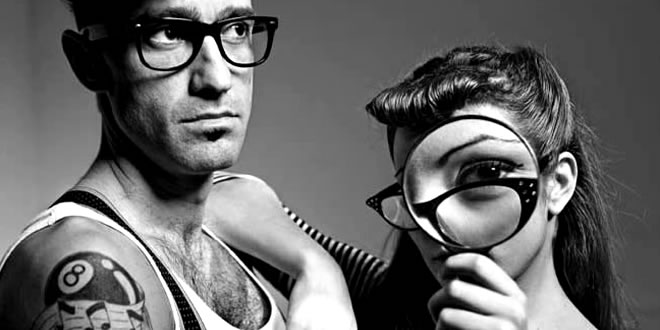22 March, 2012
A Stitch In Time: The Hottest Thing From The North To Come Out Of The South
I’ve already explained that the word rockabilly comes from a portmanteau of ‘rock’ from the 50s rock ‘n’ roll and ‘hillbilly’ from the 40s and 50s country music but the genre also encompasses western swing, blues, boogie woogie and jump blues – all of which have had their own influence over the fashions from way back when, all the way into the present.
Rockabilly fashion challenged the conservative look of the post war era and saw the wholesome pin up girl of the 40s give way to the racy girls of the B-movies, pulp fiction novels and the underground beginnings of the Sexual Revolution thanks to fetish pin ups like Bettie Page.
Social class also played a large part in inspiring the wardrobes of youths and the film ‘West Side Story’ is a perfect example of this. Those on the ‘right’ side of the tracks preferred to adopt a clean cut look with just a dash of ‘edge’ while those from the ‘wrong’ side of the tracks experimented with vibrant colours and patterns, boots and leather jackets.
For the girls, the full skirts and dresses supported by crinoline petticoats were teamed with flat shoes or low ‘kitten’ heels and ponytails to give a girlie edge to the 50s look. Those who wanted to channel their inner bad girl opted for ‘scandalous’ tight sweaters and figure hugging pencil skirts in bold prints with stiletto heels, bright accessories, teased hair and red lipstick adding the finishing touch to their man eater looks.
As regional influences slowly crept into fashion consciousness quite a bit of Western and South Western inspired fashion could be seen. Embroidered gabardine and satin shirts and gingham western snap shirts made their way into wardrobes with stars like Patsy Cline making the fringed western look popular.
This also saw the rise of the patio or ‘squaw’ set, opting for a more casual look of wedges or sandals teamed with espadrilles. As the jump jive scenes of Harlem fused with European influences, swanky draped Hollywood pants, rayon loop shirts and 2 tone oxfords also emerged.

Social class also played a large part in inspiring the wardrobes of youths and the film ‘West Side Story’ is a perfect example of this. Those on the ‘right’ side of the tracks preferred to adopt a clean cut look with just a dash of ‘edge’ while those from the ‘wrong’ side of the tracks experimented with vibrant colours and patterns, boots and leather jackets.
While jeans were a wardrobe staple, the wide cuff was a natural progression rather than a fashion statement as most pants were either hand-me-downs or were bought long to allow for growing room. Although born of necessity rather than trend, the wide cuff look has endured as a mainstay of the modern rockabilly look.
Shirts and jackets were simple cotton or gabardine button downs which weren’t too expensive or flashy and the ‘good’ guy’s shoe of choice was the standard black oxford. Guys from economic and social backgrounds that allowed a little more room to rebel, had wardrobes of two tone shirts and jackets, atomic or novelty prints, engineer boots and leather jackets.
Shirts and jackets were simple cotton or gabardine button downs which weren’t too expensive or flashy and the ‘good’ guy’s shoe of choice was the standard black oxford. Guys from economic and social backgrounds that allowed a little more room to rebel, had wardrobes of two tone shirts and jackets, atomic or novelty prints, engineer boots and leather jackets.
For the girls, the full skirts and dresses supported by crinoline petticoats were teamed with flat shoes or low ‘kitten’ heels and ponytails to give a girlie edge to the 50s look. Those who wanted to channel their inner bad girl opted for ‘scandalous’ tight sweaters and figure hugging pencil skirts in bold prints with stiletto heels, bright accessories, teased hair and red lipstick adding the finishing touch to their man eater looks.
As regional influences slowly crept into fashion consciousness quite a bit of Western and South Western inspired fashion could be seen. Embroidered gabardine and satin shirts and gingham western snap shirts made their way into wardrobes with stars like Patsy Cline making the fringed western look popular.
This also saw the rise of the patio or ‘squaw’ set, opting for a more casual look of wedges or sandals teamed with espadrilles. As the jump jive scenes of Harlem fused with European influences, swanky draped Hollywood pants, rayon loop shirts and 2 tone oxfords also emerged.
While the rockabilly revival has taken place over the years, the period itself was a relatively small window of time. Not easily defined, it is a unique and readily identifiable look that encompasses a variety of clothing styles that are now referred to as ‘rockabilly’. Just as not all 20s fashion is considered a ‘flapper’ look, not all clothing from the 50s and 60s is considered rockabilly. However this influential style remains an enduring look within the realms of fashion, design and modern vintage enthusiasts.
So stick with me and in the coming weeks we'll cover these styles and sihllouettes in more detail!

Subscribe to:
Post Comments (Atom)























0 comments (+add yours?)
Post a Comment
♥ Leave me some love ♥